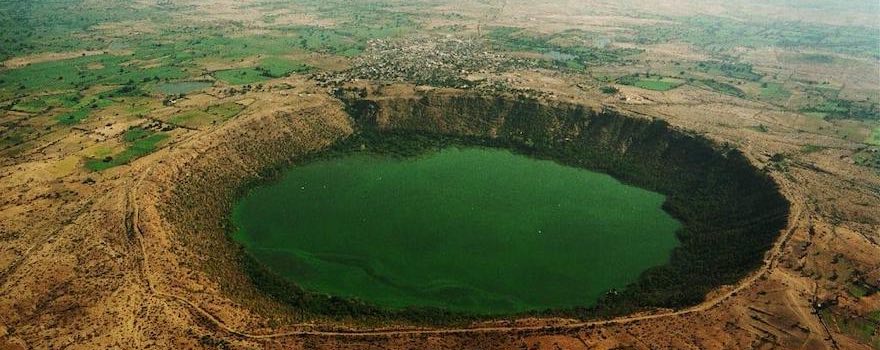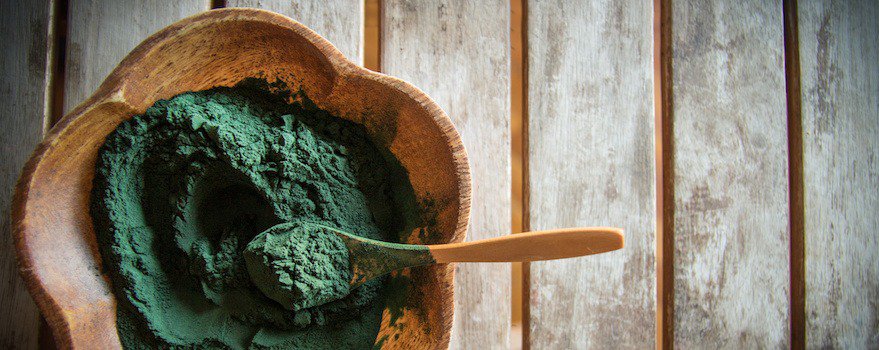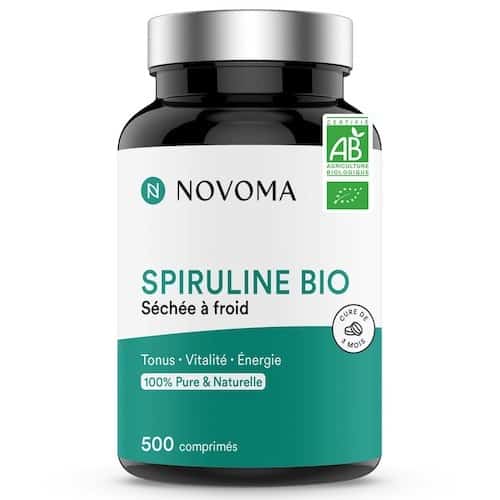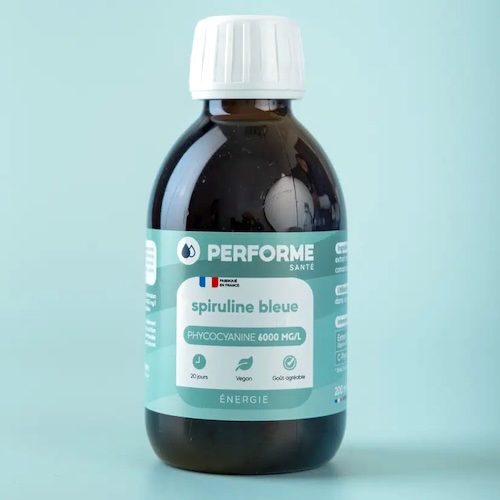Best spirulina: our review
We analyzed 14 brands according to 6 quality criteria, and selected these 3 spirulina supplements:
# Best value for money 🥇
> Organic Spirulina – Novoma
# Best spirulina in tablet form
> The Organic Spirulina – Nutri&Co
# Best liquid spirulina
> Blue Spirulina 6000 – Performe
Our selection criteria
- Phycocyanin rate: phycocyanin is the most important active compound in spirulina. The higher this rate, the better.
- No additives: products guaranteed without preservatives, flavorings, or colorings.
- Compliance of microbiological analyses: the brand must be able to provide independent analyses of phycocyanin levels, heavy metals and microcystins (toxins).
- Price / tablet : this is the price per 500 mg tablet.
- Customer reviews : these reviews are collected from specialized platforms such as TrustPilot or Ekomi.
- Our opinion on the brand : based on the supplement brand tests we conduct each month.
All dietary supplements selected below are certified organic, 100% pure and made in France.
# BEST VALUE FOR MONEY 🥇
Brand : Novoma
Phycocyanin content : 16%
Additives absent : yes
Microbiological analyses compliance: available online and compliant
Price per tablet : €0.47
Customer reviews : 4.7/5 (truspilot.com)
Novoma spirulina offers a sufficient phycocyanin content of 16%.
Spirulina is dried and cold-compressed, allowing an effective concentration of proteins, minerals and vitamins. The 65% protein content is specified.
The 500 mg spirulina tablets are additive-free. They are small and easy to swallow. The dosage recommendations are 6 tablets per day, which corresponds to the effective doses used in clinical studies.
The bottles are recyclable and opaque: they do not allow light in, which helps improve the preservation of the tablets.
The Novoma laboratory provides bacteriological and heavy metal analyses, from an independent laboratory. The spirulina is cultivated in India and packaged in France, and is certified organic.
Novoma produces or manufactures its products in Toulouse, in accordance with French standards. The supplements are guaranteed non-GMO, gluten-free, free of magnesium stearate and cruelty free.
Considering the quality at an affordable price, for us it’s the spirulina tablets that offer the best value for money.

Maxime Mességué
Dietitian nutritionist
Je recommande 1 à 5 g par jour et jusqu’à 10 g pour les personnes très sportives. Il convient d’augmenter les doses progressivement pour améliorer la tolérance.
Attention à choisir une spiruline de qualité, biologique et garantie sans pesticide et métaux lourds.
# BEST SPIRULINA IN TABLET FORM
Brand : Nutri&Co
Phycocyanin content : 20-25%
No additives : yes
Microbiological analysis compliance: available online and compliant
Price / tablet : €0.54
Customer reviews : 4.8/5 (ekomi.fr)
We selected this spirulina because it has a high (>20%) and stable phycocyanin content, and because its traceability is rigorous. It is organic and grown in France.
This spirulina is dried and then cold-compressed, to preserve all of its nutrients (RAW™ certification) and thus maximize its benefits for the body.
We like the Nutri&Co brand because it is reliable and transparent (read our full review here to learn more). We also note that customer reviews are very good.
This nutraceutical expert company is based in Aix-en-Provence and places particular importance on the quality of the active ingredients in its products.
# BEST CONCENTRATED SPIRULINA
Brand : Performe
Phycocyanin content : 6000 mg / L
Absence of additives : yes
Microbiological analysis compliance: available on request and compliant
Price / day : €2.95
Customer reviews : 4.8/5 (societe-des-avis-garantis.fr)
Performe’s Spiruline Bleue 6000 is the supplement that presents the highest concentration of phycocyanin, the main active ingredient of spirulina (that is 6,000 mg per liter).
This liquid form, tasteless and odorless, is particularly appreciated for its ease of use and high absorption. It differs from dried spirulina flakes or tablets by the absence of reported digestive issues and by rapid absorption.
Performe’s Spiruline Bleue is ideal for people experiencing significant fatigue, stress, or in a phase of physical recovery.
Known for its strict standards in quality and traceability, Performe cultivates its spirulina in a laboratory located in Perpignan, 100% self-sufficient in energy and water.
With over 25 years of expertise, the brand is now considered a reference for blue liquid spirulina in France.
# BEST ENTRY-LEVEL
Marque : Nutrimea
Taux phycocyanine : 12%-19%
Absence d’additifs : oui
Conformité des analyses microbiologiques : absence de métaux lourds. Pas d’analyse sur l’absence de microcystine.
Prix / comprimé : 0,46€
Avis clients : 4,6/5 (avis-verifies.com)
The spirulina from the Nutrimea laboratory is dosed at 500 mg per tablet, containing 12 to 19% phycocyanin.
The opaque bottle ensures optimal protection against oxidation. The daily dosage recommended by the laboratory is 3 tablets per day, which is lower than recommended.
The protein content is indicated, which is a sign of quality: Nutrimea guarantees 60% protein in the spirulina, and the tablets contain no excipients or additives.
Nutrimea’s spirulina is cultivated on the Mongolian high plateaus and is certified organic. The analysis certificate is not available online.
Nutrimea is a French company founded in 2012 that offers products meeting the highest certification standards and manufactured from natural raw materials of controlled origin.
Comprehensive comparison
In our comparison, we selected spirulina tablets meeting the following minimum criteria:
- Organic label
- Packaged in France
- At least 15% phycocyanin (the active ingredient of spirulina)
- Dried and cold-pressed
- No excipients.
| Phycocyanin rate. | Customer reviews | |
| #1 Performe | 6000 mg/L | 4.8 / 5 |
| #1 Nutri&co | 20% | 4.8 / 5 |
| #2 Novoma | 16% | 4.7 / 5 |
| #4 Nutrimea | 12-19% | 4.6 / 5 |
| #5 Natura Force | 15% | 4.7 / 5 |
| #6 Anastore | N/A | 4.7 / 5 |
What are the benefits of spirulina ?
A superfood 3.5 billion years old
The spirulina has the scientific name Arthrospira platensis. It first appeared on Earth 3.5 billion years ago.
Unlike chlorella, with which it is often confused, spirulina is not a microalga but a cyanobacterium. This group of bacteria lives in colonies and grows through photosynthesis.
In its natural state, spirulina is found in warm, alkaline waters such as those of Lake Chad or Lake Texcoco in Mexico. Today, it is also cultivated in artificial ponds and even in urban farms like in Bangkok.
It is then processed into a dietary supplement and marketed as powder, flakes, capsules, or tablets.

Maxime Mességué
Dietitian nutritionist
La spiruline est une cyanobactérie riche en phycocyanine, un antioxydant puissant.
Elle contient également de nombreux micro-nutriments comme le fer, le magnésium et les vitamines A, E et B.
Nourishes, protects, and strengthens the body
If spirulina is today considered the food of the future, it’s because it is very nutritious and can help address a large number of deficiencies. Thus, it contains up to 70% protein but also amino acids (including the 8 essential ones), vitamins, minerals and trace elements, omega-6s and antioxidant pigments.
Spirulina is a superfood ideal for vegetarians or vegans looking for alternatives to animal proteins. It will also help flexitarians reduce their meat consumption a bit more.
However, note: spirulina doses should not exceed 4 to 10 grams per day, and the recommended daily protein intake for an adult ranges between 0.83 and 2.2 g of protein per kilogram per day.
In the case of a vegan diet, spirulina supplementation is not sufficient to meet the daily protein requirement.
Furthermore, if you are concerned about the environmental impact of your diet, know that spirulina cultivation is eco-friendly. Indeed, it requires few resources and needs 20 times less water than cereal farming! Even better, it absorbs CO2.
As shown by this study, spirulina strengthens the immune system and natural defenses. At the same time, its antioxidants, including the phycocyanin and chlorophyll, protect the body from free radicals and their harmful effects.
Finally, spirulina is a natural anti-fatigue remedy. It notably improves athletic performance thanks to its high content of vitamins and iron.

Where to buy spirulina?
Organic stores
In France, organic spirulina does not exist because its cultivation requires fertilizers, such as mineral nitrogen, which are not permitted by the organic farming specifications.
However, health food stores, such as Naturalia or Biocoop, can offer you spirulina grown without chemicals, non-GMO and non-irradiated, imported from abroad.
Pharmacies and parapharmacies
Pharmacies and drugstores offer spirulina in capsules or tablets. But they often contain binders, preservatives, or other additives.
Specialty brick-and-mortar stores
Many shops specializing in dietary supplements and stores selling dietary products offer spirulina. You can also find it in sports nutrition shops.
Specialized online shops and e-commerce stores
The internet offers a wide selection of spirulina. You can order from online health food stores or from specialized laboratories such as Nutrimea, Nutri&Co or Natura Force.
Producers
France has more and more spirulina growers, grouped within the Federation of Spirulina Producers of France. Buying directly from the producers guarantees traceable, artisanal spirulina that is often of much higher quality.

In what form ?
Fresh spirulina: the best on the market
If you obtain your supply directly from producers, you may find fresh spirulina. Rich in nutrients, it is ideal for preparing health drinks, smoothies and creative recipes.
In capsules and tablets: for supplement courses
Capsules and tablets contain spirulina that has been dried and ground into powder. It’s a convenient form that has the advantage of not conveying spirulina’s iodine-like taste, and well suited for a course of supplementation.
These forms may contain additives to mask the taste of the algae.
Powdered: for cooking
Like fresh spirulina, spirulina powder is used in cooking, for preparing drinks and savory or sweet recipes. It’s the easiest form to find on the market.
Flakes: the most convenient
Flakes are the most natural and least processed form. Once harvested, the spirulina is simply pressed, dried, then ground by hand.
This produces small strands to sprinkle over a salad, yogurt, or to dissolve in your drinks…

Precautions for use and side effects
Diarrhea, headaches, and nausea may occur at the start of a course: I recommend that you reduce the dosage and gradually increase it again if you tolerate it.
Spirulina requires medical approval if you suffer from kidney problems, iron malabsorption, or if you are on anticoagulant therapy.
It is contraindicated in cases of phenylketonuria.
What criteria should be considered ?
Not all spirulina products are equal and there are large disparities in terms of quality. That’s why it’s important to take the criteria below into account.
1. Phycocyanin content
Phycocyanin is a blue-green pigment and the main active component of spirulina. It accounts for up to 18% of its composition.
To obtain results, it is therefore important to choose a dietary supplement that is sufficiently concentrated and standardized for phycocyanin (at least 15%).
2. Production method
Spirulina acts like a sponge: it readily absorbs heavy metals and chemicals present in its environment. The presence of lead and mercury is, in fact, one of the dangers of spirulina.
Spirulina can also contain other forms of bacteria in small amounts, notably microcystins: these can release toxins with a harmful effect on the liver, kidneys, and nervous system during chronic exposure.
Prefer artisanal spirulina, cultivated without chemicals, in pure water and in as unpolluted an environment as possible. Demand transparency about production methods.
3. Drying method
Phycocyanin, the blue-green pigment that gives spirulina its color, degrades at high temperatures. This pigment is responsible for a major part of the therapeutic effects.
The drying process therefore has a direct impact on the final quality of spirulina. Prefer raw spirulina, that is cold-dried (below 42°C). This gentle process preserves all the qualities and nutrients of the cyanobacterium.
4. Composition
Capsules and tablets may have undergone extensive processing and may not be made of 100% spirulina. They can contain additives, binders, colorants, preservatives… especially if they come from large industrial producers. Additives can even be found in some organic products that do not originate from the European Union.
Prefer plant-based capsules that are as natural as possible.
The powder and spirulina flakes, for their part, must be 100% pure.
5. Geographic origin
A large portion of the spirulina consumed in France is produced abroad, notably in China and India. It is generally cheaper but is sometimes grown according to less strict environmental and sanitary standards. Thus, there have been cases of Chinese spirulina being contaminated with heavy metals.
Don’t hesitate to buy French spirulina, it’s very often a sign of quality.
If you choose foreign spirulina, check its quality and non-toxicity with the retailers, who generally carry out tests in certified laboratories.
In that case, opt for natural, organic spirulina: that’s an advantage of some spirulina from Africa or Asia, which can grow in lakes in their natural state.
But be cautious about spirulina labeled organic: in France, most of these products come from abroad, because industrial cultivation is easier there.
Nevertheless, the organic certification criteria of countries outside the European Union are more lenient, and their organic specifications are recognized by Europe. Spirulina originating from India or China can thus end up labeled organic on French shelves, while a small local producer of better quality will not have organic certification!
6. Price
A quality spirulina, sold in capsules or tablets, has a price per kilo between €120 and €150. Expect between €18 and €25 for a box of 150 spirulina capsules.
- The selling price for fresh, farm-raised French spirulina is about €160 per kg.
- 100% pure spirulina powder is offered at around €25 per 500 g.
- For spirulina flakes from France, expect between €22 and €28 per 100 g.

To summarize
To be sure you’re choosing quality spirulina, check:
- Phycocyanin concentration : choose a supplement with at least 15% phycocyanin
- Cultivation method : it should be grown in pure water and an unpolluted environment, without chemicals
- Drying process : prefer raw, cold-dried spirulina
- Composition : choose a product without additives, preservatives or colorants. The powder and flakes should be 100% pure and natural
- Geographical origin : choose spirulina cultivated in France and pay attention to the reputation of the supplement brand. Be cautious about organic labels.
- Price : it should be between €18 and €25 for 150 capsules, around €25 for powder and flakes. Fresh spirulina is sold at about €160 per kg.
When you purchase the selected products, a commission may be paid to us to support the site, compensate our writers, and ensure you receive high-quality information. This does not affect prices.
Frequently Asked Questions (FAQ)
How should you take spirulina?
Spirulina is consumed raw, as powder, flakes, capsules, and tablets. It is recommended to pair it with vitamin C, one of the few vitamins it lacks, to help iron absorption. The recommended intake is 2 to 5 g of spirulina per day, increasing doses gradually. Avoid exceeding 10 g per day.
Where to buy spirulina?
Spirulina can be found in health food stores, in pharmacies and parapharmacies, directly from spirulina producers, or online for more choice.
When to take spirulina?
There is no ideal time of day to take spirulina. It can be consumed during meals, incorporated into your dishes (as powder or flakes), or at other times of the day as a dietary supplement (capsules and tablets).
What is the best spirulina?
Following the analysis of 8 spirulina supplements sold online, we selected Nutri&Co’s organic spirulina.
What is the difference between spirulina and chlorella?
These two foods are complementary microalgae. Chlorella is more focused on detoxifying the body and on preventing winter illnesses. Its tryptophan content makes it more beneficial than spirulina for improving mental well-being and easing sleep problems. Finally, opt for chlorella if you want to lose weight. Richer in iron and vitamin C than chlorella, spirulina is preferable for improving athletic performance. It is also recommended to combat free radicals and oxidative stress. Because of its beta-carotene content, spirulina is also ideal for reducing bad cholesterol levels.
Report prepared by Louise Talleu (pharmacist) and Julia Perez (health writer).
When you purchase the selected products, a commission may be paid to us to support the site, compensate our writers, and ensure you receive high-quality information. This does not affect prices.







